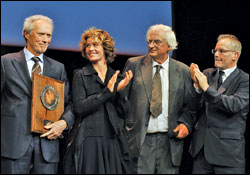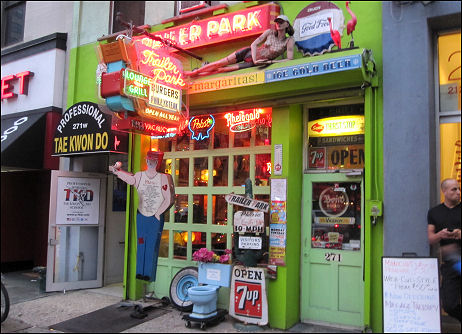“Anyone can formulate a personal version of heaven — an aerie of angels, a tropical getaway, a cloister with 72 virgins, a sports bar with unlimited beer and bigscreen, or an ethereal place where you could mingle and chat with everyone from Socrates to Groucho Marx,” Variety‘s Todd McCarthy wrote in a 10.22 column. “Last week I discovered the closest approximation of paradise I can imagine for the hardcore film buff at the Grand Lyon Film Festival in the center of France.

(l. to r.) Clint Eastwood, Cecile de France, Bertrand Tavernier, Therry Fremaux.
“This six-day event was defined by three elements: reliably fine films, incredible food and good, smart people to share both with. This setting afforded attendees a state not of ecstasy, perhaps, but of a consistently high mellowness.
“The St. Peter of this blissful environment was Thierry Fremaux. Though Fremaux is best known to the world as major domo of the Cannes Film Festival, his professional base has long been his native Lyon. There, working with fellow Lyonnois Bertrand Tavernier, he has been director of the Institute Lumiere, a superbly administered shrine to the fathers of cinema, Auguste and Louis Lumiere. The brothers’ stately home is maintained as a beautiful museum devoted to the movies’ earliest days in the 1890s; right next to it is an intimate modern cinema where the institute runs an outstanding year-round screening schedule of classics, strongly contributing to the city’s conspicuously avid and film-literate population.
“The new film festival could accurately be called ‘Cannes Classics X 10,’ a notable magnification of the annual Cannes sidebar Fremaux initiated to spotlight the latest in global archival restorations. Part of Lyon’s charm is that it doesn’t show bad films. The reason is that it doesn’t show any new ones, except for the odd documentary about cinema subjects.
“In the fest’s inaugural year, two of the major retrospectives were devoted to Sergio Leone (the complete works) and Don Siegel. The first Prix Lumiere, an award Fremaux expects to present annually and ambitiously conceives of as ‘the Nobel Prize of cinema, was bestowed upon Clint Eastwood, many of whose films as a director were also shown.
“The 79-year-old actor-auteur was busy in Lyon for four days, during which he was feted as the special guest at several dinners; gave a press conference introducing Siegel’s 1958 pic The Lineup; accepted his fest award at a public ceremony before 3,000 people; kicked an opening ball at a soccer game in front of 40,000 fans; and introduced a large-screen showing of a new print of The Good, the Bad and the Ugly for 5,000 rabid cinephiles.
“At each event he caused a rock star-like frenzy. Fremaux was able to lure nearly 40 international directors to the fest’s opening night; within my first five minutes at a reception, I bumped into Alfonso Cuaron, Jerry Schatzberg, Emir Kusturica and Claude Lelouch. The great restaurant Le Passage functioned as the festival’s canteen, open at nearly all hours, and the central tented meeting place featured an embarrassment of enticing books and DVDs for sale.
“To my knowledge, there isn’t another film festival quite like Lyon anywhere else in the world. Bologna specializes in old films and rarities but remains rarefied rather than public, Pordenone focuses on silent cinema, Telluride maintains equally high standards but concentrates on the new. Roger Ebert‘s annual fest is perhaps closest in its devotion to past and neglected glories but shows far less.”










